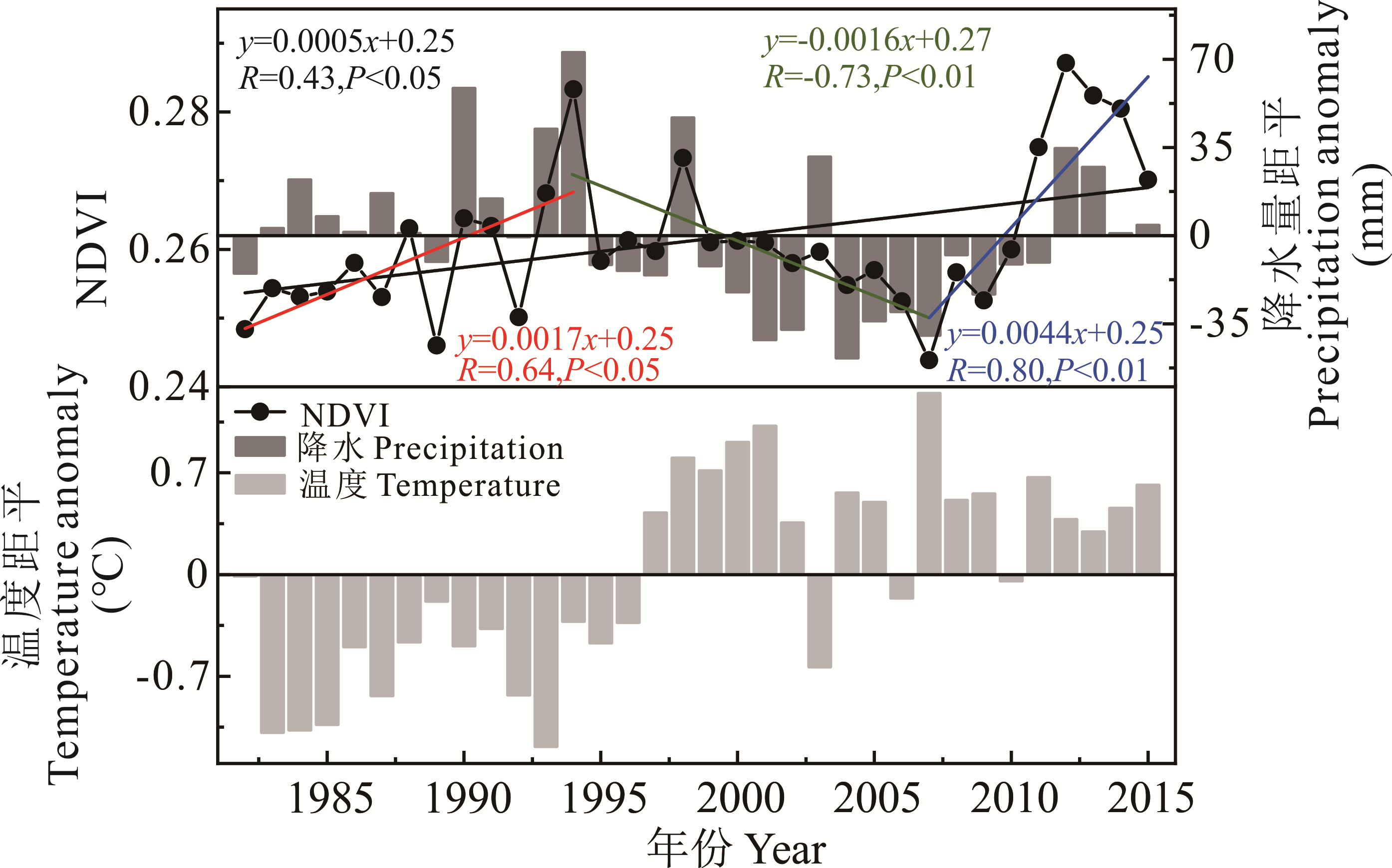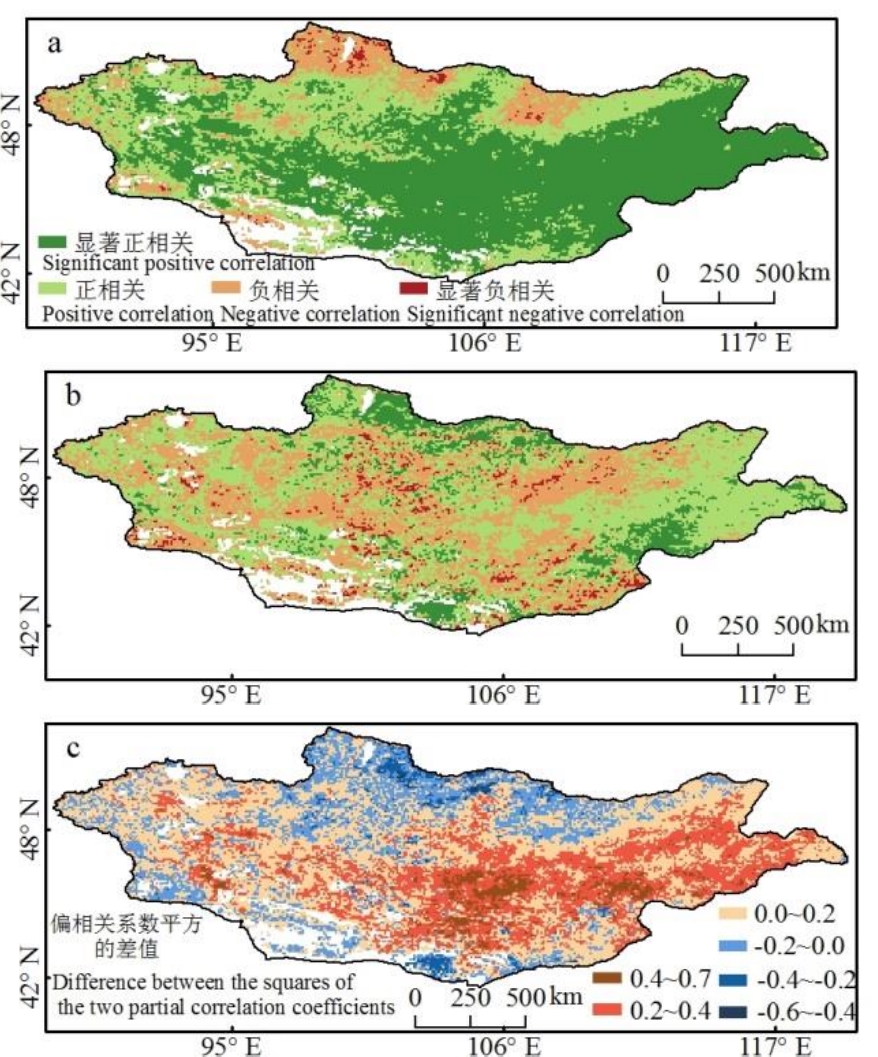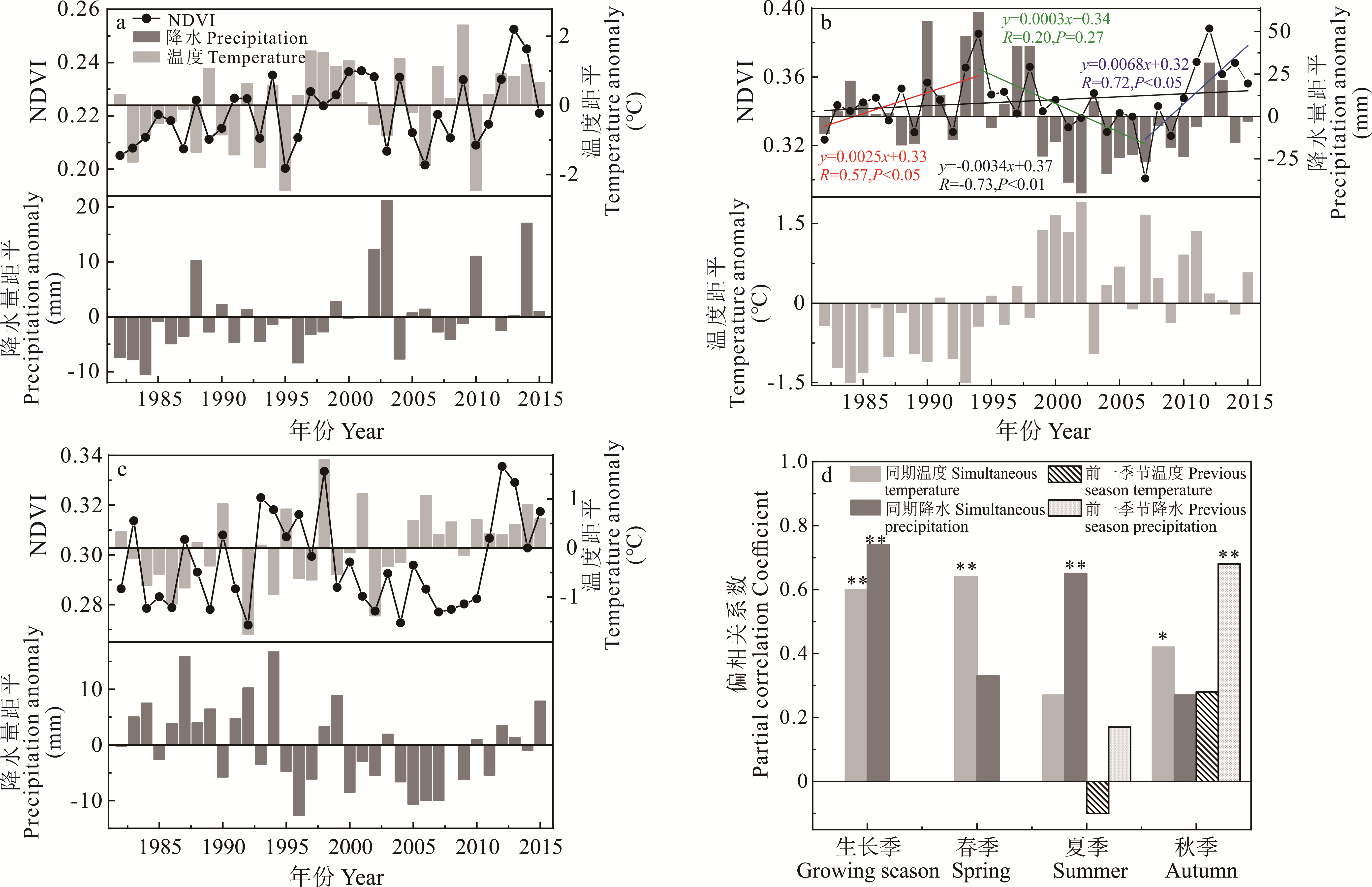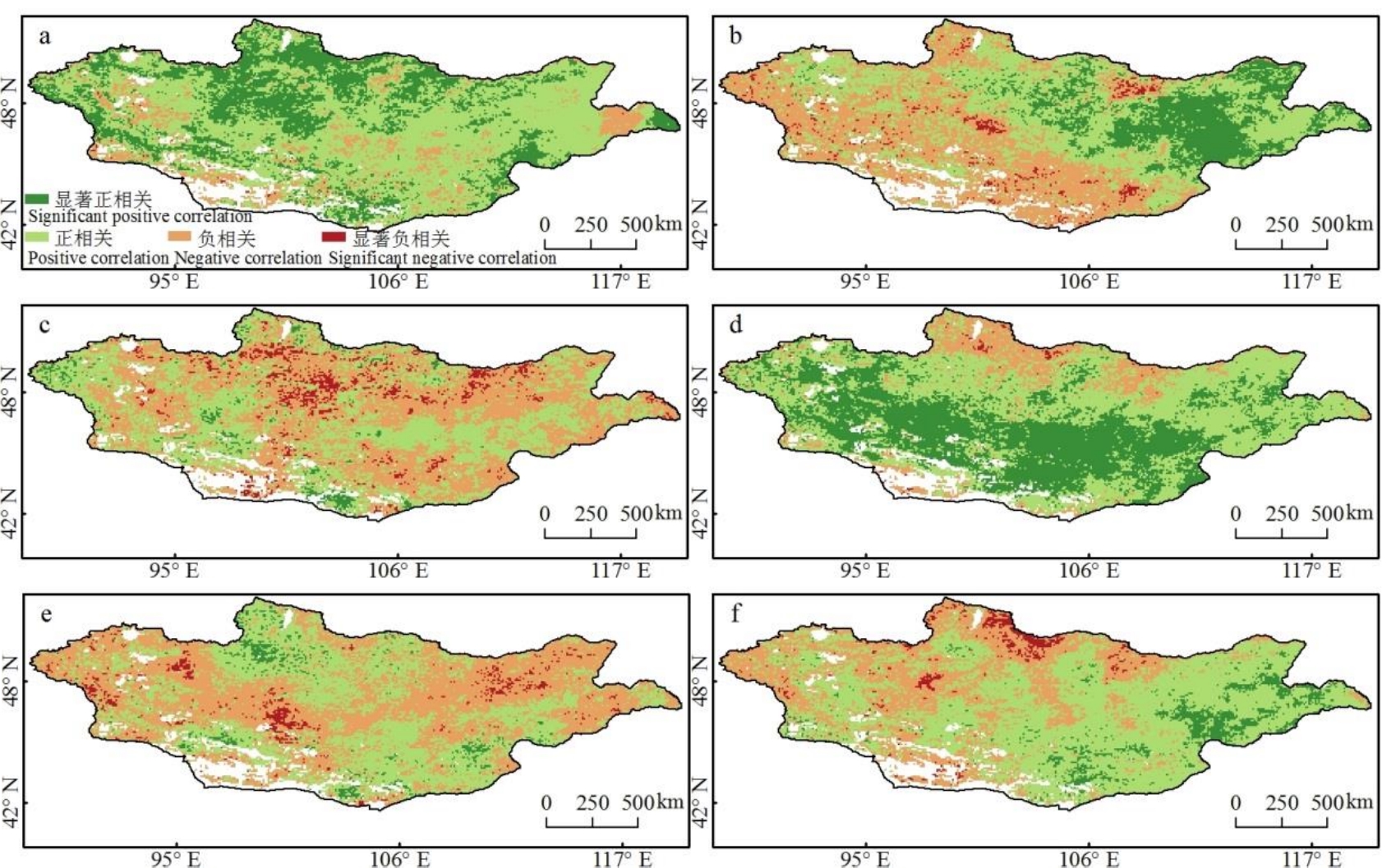

ISSN 1004-5759 CN 62-1105/S


草业学报 ›› 2021, Vol. 30 ›› Issue (2): 1-13.DOI: 10.11686/cyxb2020311
杜佳梦1( ), 包刚1,2,3(
), 包刚1,2,3( ), 佟斯琴1,2, 黄晓君1,2, 温都日娜1, 美丽1, 包玉海1,2
), 佟斯琴1,2, 黄晓君1,2, 温都日娜1, 美丽1, 包玉海1,2
收稿日期:2020-07-06
修回日期:2020-09-21
出版日期:2021-02-20
发布日期:2021-01-19
通讯作者:
包刚
作者简介:E-mail: baogang@imnu.edu.cn基金资助:
Jia-meng DU1( ), Gang BAO1,2,3(
), Gang BAO1,2,3( ), Si-qin TONG1,2, Xiao-jun HUANG1,2, Wendurina1, Meili1, Yu-hai BAO1,2
), Si-qin TONG1,2, Xiao-jun HUANG1,2, Wendurina1, Meili1, Yu-hai BAO1,2
Received:2020-07-06
Revised:2020-09-21
Online:2021-02-20
Published:2021-01-19
Contact:
Gang BAO
摘要:
基于1982-2015年间GIMMS NDVI3g数据、气象数据和植被类型数据,采用趋势分析、偏相关性分析和残差分析等方法,从不同时空尺度上分析蒙古国植被NDVI空间格局、变化趋势及其主要原因。结果表明,过去34年间蒙古国生长季平均NDVI在空间上由南向北逐渐增加,具有显著的纬度地带性分布特征,并随着海拔的升高而降低。生长季NDVI阶段性变化特征明显,1982-1994年和2007-2015年间呈显著增加趋势,而1994-2007年间呈显著下降。从34年的观测尺度看,NDVI以每年0.0005的速率呈显著增加趋势,其变化趋势与降水量的关系较密切,两者之间的偏相关系数为0.74。在空间分布上,植被显著增加的区域主要分布在西部大湖盆地、杭爱山脉、戈壁阿尔泰山脉和北部森林区,其对气候的响应因季节和地区而异。从季节上看,总体上3个季节NDVI均呈增加趋势,其中夏季NDVI波动与生长季的波动一致,主要受降水量的控制,其主要原因为夏季生产力占全年生产力的比重较高有关。春季和秋季NDVI对温度的响应明显。残差分析表明,人类活动是蒙古国植被NDVI变化的另一重要影响因素,特别是在人口密度较大的地区(蒙古国西部高山地区和中部草原地区),植被NDVI的变化受人类活动影响明显。
杜佳梦, 包刚, 佟斯琴, 黄晓君, 温都日娜, 美丽, 包玉海. 1982-2015年蒙古国植被覆盖变化及其与气候变化和人类活动的关系[J]. 草业学报, 2021, 30(2): 1-13.
Jia-meng DU, Gang BAO, Si-qin TONG, Xiao-jun HUANG, Wendurina, Meili, Yu-hai BAO. Variations in vegetation cover and its relationship with climate change and human activities in Mongolia during the period 1982-2015[J]. Acta Prataculturae Sinica, 2021, 30(2): 1-13.

图1 蒙古国高程(a)、温度(b)、降水(c)及植被类型(d)的空间分布格局
Fig.1 Spatial distribution pattern of elevation (a), temperature (b), precipitation (c) and vegetation type (d) in Mongolia

图3 1982-2015年蒙古国植被生长季平均NDVI纬度(a~c)和海拔(d)梯度上的变化特征
Fig.3 Variations of growing season NDVI along latitude (a-c) and altitude (d) gradients in Mongolia from 1982 to 2015

图4 1982-2015年蒙古国生长季NDVI、降水量和温度的年际变化
Fig.4 Interannual variation of NDVI, precipitation and temperature in growing season of Mongolia from 1982 to 2015
变化类型 Type of change | 年Year | |||
|---|---|---|---|---|
| 1982-2015 | 1982-1994 | 1994-2007 | 2007-2015 | |
无显著增加 Insignificant increase | 33.8 | 65.3 | 17.9 | 51.4 |
显著增加 Significant increase | 32.8 | 22.8 | 1.7 | 26.8 |
显著减小 Significant decrease | 8.9 | 0.5 | 22.9 | 2.2 |
无显著减小 Insignificant decrease | 24.5 | 11.4 | 57.5 | 19.6 |
表1 蒙古国不同时段NDVI变化趋势的面积百分比
Table 1 Area percentage of NDVI change trend in Mongolia during different periods (%)
变化类型 Type of change | 年Year | |||
|---|---|---|---|---|
| 1982-2015 | 1982-1994 | 1994-2007 | 2007-2015 | |
无显著增加 Insignificant increase | 33.8 | 65.3 | 17.9 | 51.4 |
显著增加 Significant increase | 32.8 | 22.8 | 1.7 | 26.8 |
显著减小 Significant decrease | 8.9 | 0.5 | 22.9 | 2.2 |
无显著减小 Insignificant decrease | 24.5 | 11.4 | 57.5 | 19.6 |

图5 蒙古国1982-2015(a)、1982-1994(b)、1994-2007(c)和2007-2015年(d)生长季NDVI变化趋势的空间分布
Fig.5 Spatial distribution of growing season NDVI change trend in Mongolia from 1982 to 2015 (a), 1982 to 1994 (b), 1994 to 2007 (c) and 2007 to 2015 (d)

图6 1982-2015年蒙古国生长季NDVI与降水(a)和温度(b)的偏相关性及两个偏相关系数的平方之差(c)
Fig.6 Partial correlation between growing season NDVI and precipitation (a), temperature (b) and the difference between the squares of the two partial correlation coefficients (c) in Mongolia from 1982 to 2015

图7 1982-2015年蒙古国春季(a)、夏季(b)和秋季(c)NDVI、降水量和温度的年际变化及不同季节NDVI与气候因子的偏相关关系(d)*代表P<0.05,**代表P<0.01 (下同)。* represents P<0.05,** represents P<0.01 (The same below).
Fig.7 The interannual changes of NDVI, precipitation and temperature in spring (a), summer (b), autumn (c) and the partial correlation between NDVI and climate factors in different seasons (d) from 1982 to 2015 in Mongolia

图8 1982-2015年蒙古国各季节NDVI与温度和降水偏相关性的空间分布a、c、e 分别表示NDVI与春、夏和秋季温度的相关性,b、d、f表示NDVI与春、夏和秋季降水的相关性。a, c and e respectively represent correlation between NDVI and temperature in spring, summer and autumn, and b, d and f represent correlation between NDVI and precipitation in spring, summer and autumn.
Fig.8 Spatial distribution of partial correlation between NDVI and precipitation and temperature in various seasons in Mongolia from 1982 to 2015

图9 不同植被类型NDVI与温度和降水之间的偏相关关系NDVI夏、NDVI秋代表夏季和秋季NDVI,T春、P春代表春季温度和降水,T夏、P夏代表夏季温度和降水。NDVIsum and NDVIaut represent NDVI in summer and autumn, Tspr and Pspr represent temperature and precipitation in spring, Tsum and Psum represent temperature and precipitation in summer.
Fig.9 Partial correlations between NDVI of different vegetation types with temperature and precipitation
| 1 | Walker B, Steffen W. IGBP science No.1: A synthesis of GCTE and related research. Stockholm: IGBP, 1997: 1-24. |
| 2 | Piao S L, Fang J Y. Seasonal changes in vegetation activity in response to climate changes in China between 1982 and 1999. Acta Geographica Sinica, 2003, 58(1): 119-125. |
| 朴世龙, 方精云. 1982-1999年我国陆地植被活动对气候变化响应的季节差异. 地理学报, 2003, 58(1): 119-125. | |
| 3 | Wang X H, Piao S L, Ciais P, et al. Spring temperature change and its implication in the change of vegetation growth in North America from 1982 to 2006. Proceedings of the National Academy of Sciences, 2011, 108(4): 1240-1245. |
| 4 | Zhou W, Gang C C, Li J L, et al. Spatial-temporal dynamics of grassland coverage and its response to climate change in China during 1982-2010. Acta Geographica Sinica, 2014, 69(1): 15-30. |
| 周伟, 刚成诚, 李建龙, 等. 1982-2010年中国草地覆盖度的时空动态及其对气候变化的响应. 地理学报, 2014 , 69(1): 15-30. | |
| 5 | Mu S J, Li J L, Chen Y Z, et al. Spatial differences of variations of vegetation coverage in Inner Mongolia during 2001-2010. Acta Geographica Sinica, 2012, 67(9): 1255-1268. |
| 穆少杰, 李建龙, 陈奕兆, 等. 2001-2010年内蒙古植被覆盖度时空变化特征. 地理学报, 2012, 67(9): 1255-1268. | |
| 6 | Sun Y L, Guo P, Yan X D, et al. Dynamics of vegetation cover and its relationship with climate change and human activities in Inner Mongolia. Journal of Natural Resources, 2010, 25(3): 407-414. |
| 孙艳玲, 郭鹏, 延晓冬, 等. 内蒙古植被覆盖变化及其与气候、人类活动的关系. 自然资源学报, 2010, 25(3): 407-414. | |
| 7 | Chen F, Liu H J, Liu S J, et al. MODIS-based desertification dynamic monitoring in Mongolia from 2003 to 2017. Journal of Northwest Forestry University, 2019, 34(5): 167-171. |
| 陈芳, 刘虎俊, 刘淑娟, 等. 基于MODIS的蒙古国2003-2017年荒漠化动态监测. 西北林学院学报, 2019, 34(5): 167-171. | |
| 8 | Wang J L, Cheng K, Zhu J X, et al. Development and pattern analysis of Mongolian land cover data products with 30 meters resolution. Journal of Geo-information Science, 2018, 20(9): 1263-1273. |
| 王卷乐, 程凯, 祝俊祥, 等. 蒙古国30米分辨率土地覆盖产品研制与空间分局分析. 地球信息科学学报, 2018, 20(9): 1263-1273. | |
| 9 | Hilker T, Natsagdorj E, Waring R H, et al. Satellite observed widespread decline in Mongolian grasslands largely due to overgrazing. Global Change Biology, 2013, 20(2): 418-428. |
| 10 | Bao G, Tuya A, Bayarsaikhan S, et al. Variations and climate constraints of terrestrial net primary productivity over Mongolia. Quaternary International, 2020, 537: 112-125. |
| 11 | Tao S, Fang J, Zhao X, et al. Rapid loss of lakes on the Mongolian Plateau. Proceedings of the National Academy of Sciences of the United States of America, 2015, 112(7): 2281-2286. |
| 12 | Tong S, Lai Q, Zhang J, et al. Spatiotemporal drought variability on the Mongolian Plateau from 1980-2014 based on the SPE I-PM, intensity analysis and Hurst exponent. Science of the Total Environment, 2018, 615: 1557-1565. |
| 13 | Li N, Bao Y L, Yin S, et al. Spatiotemporal characteristics of grassland fire in China-Mongolia border regions. Journal of Catastrophology, 2016, 31(3): 207-210. |
| 丽娜, 包玉龙, 银山, 等. 中蒙边境地区草原火时空分布特征分析. 灾害学, 2016, 31(3): 207-210. | |
| 14 | Huang X J, Xie Y W, Bao Y H, et al. Suitable distribution areas of Jas’s larch inchworm in Mongolia Plateau. Journal of Northwest A & F University (Natural Science Edition), 2018, 46(4): 98-106. |
| 黄晓君, 颉耀文, 包玉海, 等. 雅氏落叶松尺蠖在蒙古高原适生区的分布.西北农林科技大学学报(自然科学版), 2018, 46(4): 98-106. | |
| 15 | Bao G, Bao Y, Sanjjava, et al. NDVI-indicated long-term vegetation dynamics in Mongolia and their response to climate change at biome scale. International Journal of Climatology, 2015, 35: 4293-4306. |
| 16 | Bao G, Bao Y H, Qin Z H, et al. Vegetation cover changes in Mongolian Plateau and its response to seasonal climate changes in recent 10 years. Scientia Geographica Sinica, 2013, 33(5): 613-621. |
| 包刚, 包玉海, 覃志豪, 等. 近10年蒙古高原植被覆盖变化及其对气候的季节响应. 地理科学, 2013, 33(5): 613-621. | |
| 17 | Wei Y J, Zhen L, Batkhishig O, et al. Empirical study on consumption of ecosystem services and its spatial differences over the Mongolian Plateau. Resources Science, 2009, 31(10): 1677-1684. |
| 魏云洁, 甄霖, Batkhishig O, 等. 蒙古高原生态服务消费空间差异的实证研究.资源科学, 2009, 31(10): 1677-1684. | |
| 18 | Zhou X, Yamaguchi Y, Arjasakusuma S. Distinguishing the vegetation dynamics induced by anthropogenic factors using vegetation optical depth and AVHRR NDVI: A cross-border study on the Mongolian Plateau. Science of the Total Environment, 2018, 616/617: 730-743. |
| 19 | Brent N, Holben. Characteristics of maximum-value composite images from temporal AVHRR data. International Journal of Remote Sensing, 1986, 7(11): 1417-1434. |
| 20 | Jin K, Wang F, Han J Q, et al. Contribution of climatic change and human activities to vegetation NDVI change over China during 1982-2015. Acta Geographica Sinica, 2020, 75(5): 961-974. |
| 金凯, 王飞, 韩剑桥, 等. 1982-2015年中国气候变化和人类活动对植被NDVI变化的影响. 地理学报, 2020, 75(5): 961-974. | |
| 21 | Piao S, Mohammat A, Fang J, et al. NDVI-based increase in growth of temperate grasslands and its responses to climate changes in China. Global Environmental Change, 2006, 16(4): 340-348. |
| 22 | Piao S, Fang J, Zhou L, et al. Interannual variations of monthly and seasonal normalized difference vegetation index (NDVI) in China from 1982 to 1999. Journal of Geophysical Research, 2003, 108(D14): 4401. |
| 23 | Liu P, Hao L, Pan C, et al. Combined effects of climate and land management on watershed vegetation dynamics in an arid environment. Science of the Total Environment, 2017, 589: 73-88. |
| 24 | Bao G, Qin Z, Bao Y, et al. NDVI-based long-term vegetation dynamics and its response to climatic change in the Mongolian Plateau. Remote Sensing, 2014, 6: 8337-8358. |
| 25 | Bao G, Qin Z H, Bao Y H, et al. Spatial-temporal changes of vegetation cover in Mongolian Plateau during 1982-2006. Journal of Desert Research, 2013, 33(3): 918-927. |
| 包刚, 覃志豪, 包玉海, 等. 1982-2006年蒙古高原植被覆盖时空变化分析. 中国沙漠, 2013, 33(3): 918-927. | |
| 26 | Myneni R B, Keeling C D, Tucker C J, et al. Increased plant growth in the northern high latitudes from 1981 to 1991. Nature, 1997, 386(6626): 698-702. |
| 27 | Mao D, Wang Z, Luo L, et al. Integrating AVHRR and MODIS data to monitor NDVI changes and their relationships with climatic parameters in Northeast China. International Journal of Applied Earth Observation and Geoinformation, 2012, 18: 528-536. |
| 28 | Cleverly J, Eamus D, Coupe N R, et al. Soil moisture controls on phenology and productivity in a semi-arid critical zone. Science of the Total Environment, 2016, 568: 1227-1237. |
| 29 | Zhou L M, Tucker C J, Kaufmann R K, et al. Variations in northern vegetation activity inferred from satellite data of vegetation index during 1981 to 1999. Journal of Geophysical Research, 2001, 106(17): 20069-20083. |
| 30 | Bao G, Chen J, Chopping M, et al. Dynamics of net primary productivity on the Mongolian Plateau: Joint regulations of phenology and drought. International Journal of Applied Earth Observation and Geoinformation, 2019, 81: 85-97. |
| 31 | Menzel A, Sparks T H, Estrella N, et al. European phenological response to climate change matches the warming pattern. Global Change Biology, 2006, 12(10): 1969-1976. |
| 32 | Richardson A D, Keenan T F, Migliavacca M, et al. Climate change, phenology, and phenological control of vegetation feedbacks to the climate system. Agricultural and Forest Meteorology, 2013, 169: 156-173. |
| 33 | Angert A, Biraud S, Bonfils C, et al. Drier summers cancel out the CO2 uptake enhancement induced by warmer springs. Proceedings of the National Academy of Sciences of the United States of America, 2005, 102(31): 10823-10827. |
| 34 | Richardson A D, Black T A, Ciais P, et al. Influence of spring and autumn phenological transitions on forest ecosystem productivity. Philosophical Transactions of the Royal Society of London B: Biological Sciences, 2010, 365(1555): 3227-3246. |
| 35 | Mu S J, Li J L,Yang H F, et al. Spatio-temporal variation analysis of grassland net primary productivity and its relationship with climate over the past 10 years in Inner Mongolia. Acta Prataculturae Sinica, 2013, 22(3): 6-15. |
| 36 | John R, Chen J, Kim Y, et al. Differentiating anthropogenic modification and precipitation-driven change on vegetation productivity on the Mongolian Plateau. Landscape Ecology, 2016, 31(3): 547-566. |
| 37 | Fernandez G M, Allen D B. Vegetation change along gradients from water sources in three grazed Mongolian ecosystems. Plant Ecology, 2001, 157(1): 101-118. |
| 38 | Wang L, Zhen L, Liu X L, et al. Comparative studies on climate changes and influencing factors in central Mongolian Plateau Region. Geographical Research, 2008, 27(1): 171-180. |
| 王菱, 甄霖, 刘雪林, 等. 蒙古高原中部气候变化及影响因素比较研究. 地理研究, 2008, 27(1): 171-180. | |
| 39 | Peng S, Chen A, Xu L, et al. Recent change of vegetation growth trend in China. Environmental Research Letters, 2011, 6(4): 044027. |
| 40 | Piao S, Wang X, Ciais P, et al. Changes in satellite-derived vegetation growth trend in temperate and boreal Eurasia from 1982 to 2006. Global Change Biology, 2011, 17(10): 3228-3239. |
| 41 | Zhang X Z. Main models of variations of autumn vegetation greenness in the mid-latitude of north hemisphere in 1982-2011. Scientia Geographica Sinica, 2014, 34(10): 1226-1232. |
| 张学珍. 1982-2011年北半球中纬度秋季植被绿度变化的主要模态. 地理科学, 2014, 34(10): 1226-1232. | |
| 42 | Tucker C J, Slayback D A, Pinzon J E, et al. Higher northern latitude normalized difference vegetation index and growing season trends from 1982 to 1999. International Journal of Biometeorology, 2001, 45(4): 184-190. |
| 43 | Tucker C J, Dregne H E, Newcomb W W. Expansion and contraction of the sahara desert from 1980 to 1990. Science, 1991, 253(5017): 299-300. |
| 44 | Chen Y Z, Li J L, Sun Z G, et al. Spatio-temporal dynamics of grassland net primary productivity and its response to climate change in the Temperate Eurasian Steppe 1982-2008.Acta Prataculturae Sinica, 2017, 26(1): 1-12. |
| 陈奕兆, 李建龙, 孙政国, 等. 欧亚大陆草原带1982-2008年间净初级生产力时空动态及其对气候变化响应研究.草业学报, 2017, 26(1): 1-12. | |
| 45 | Mu S J, Li J L, Yang H F, et al. Spatio-temporal variation analysis of grassland net primary productivity and its relationship with climate over the past 10 years in Inner Mongolia. Acta Prataculturae Sinica, 2013, 22(3): 6-15. |
| 穆少杰, 李建龙, 杨红飞, 等. 内蒙古草地生态系统近10年NPP时空变化及其与气候的关系. 草业学报, 2013, 22(3): 6-15. | |
| 46 | Buermann W, Bikash P R, Jung M, et al. Earlier springs decrease peak summer productivity in North American boreal forests. Environmental Research Letters, 2013, 8(2): 24027. |
| 47 | Olji, Bolor, Gerelchoktu, et al. Present situation and protection in Daurian steppe ecological area. Journal of Minzu University of China (Natural Sciences Edition), 2013, 22(1): 24-26. |
| 乌力吉, 宝乐日, 格日乐朝克图, 等. 蒙古达乌尔草原生态区的现状与保护. 中央民族大学学报(自然科学版), 2013, 22(1): 24-26. | |
| 48 | Hong Y Y. Analysis of spatial-temporal changes of vegetation NDVI in border areas of China-Mongolia. Hohhot: Inner Mongolia Normal University, 2016. |
| 洪园园. 中蒙边境地区植被NDVI时空变化分析. 呼和浩特: 内蒙古师范大学, 2016. | |
| 49 | Pederson N, Leland C, Nachin B, et al. Three centuries of shifting hydroclimatic regimes across the Mongolian breadbasket. Agricultural and Forest Meteorology, 2013, 178/179: 10-20. |
| [1] | 陈宸, 井长青, 邢文渊, 邓小进, 付皓宇, 郭文章. 近20年新疆荒漠草地动态变化及其对气候变化的响应[J]. 草业学报, 2021, 30(3): 1-14. |
| [2] | 赵慧芳, 李晓东, 张东, 校瑞香. 基于MODIS数据的青海省草地地上生物量估算及影响因素研究[J]. 草业学报, 2020, 29(12): 5-16. |
| [3] | 乌尼图, 刘桂香, 杨勇, 宋向阳, 白海花. 基于光能利用率模型的内蒙古天然草原植被净初级生产力动态监测与气候因子的响应[J]. 草业学报, 2020, 29(11): 1-10. |
| [4] | 倪璐, 吴静, 李纯斌, 秦格霞, 李政, 孔婕. 近30年中国天然草地物候时空变化特征分析[J]. 草业学报, 2020, 29(1): 1-12. |
| [5] | 李重阳, 樊文涛, 李国梅, 高晶, 唐增, 宋仁德. 基于NDVI的2000-2016年青藏高原牧户草场覆盖度变化驱动力分析[J]. 草业学报, 2019, 28(10): 25-32. |
| [6] | 李红梅. 柴达木盆地气候变化对植被的影响分析[J]. 草业学报, 2018, 27(3): 13-23. |
| [7] | 葛兆轩, 孙国龙, 袁业, 黄选瑞, 张志东. 河北省森林草原区草本植物物种多样性和功能多样性[J]. 草业学报, 2017, 26(7): 35-44. |
| [8] | 李海霞, 杨井, 陈亚宁, 郝兴明. 基于MODIS数据的新疆地区土壤湿度反演[J]. 草业学报, 2017, 26(6): 16-27. |
| [9] | 张颖, 章超斌, 王钊齐, 杨悦, 张艳珍, 李建龙, 安如. 气候变化与人为活动对三江源草地生产力影响的定量研究[J]. 草业学报, 2017, 26(5): 1-14. |
| [10] | 张永, 杨自辉, 王立, 魏怀东, 惠晓雅, 张剑挥, 王强强, 郭树江, 詹科杰. 基于遥感分析13年来石羊河上游山区植被变化研究[J]. 草业学报, 2017, 26(11): 12-21. |
| [11] | 张雅娴, 樊江文, 曹巍, 张海燕. 2006-2013年三江源草地产草量的时空动态变化及其对降水的响应[J]. 草业学报, 2017, 26(10): 10-19. |
| [12] | 王玮, 郭铌, 沙莎, 胡蝶, 王小平, 李耀辉. 我国西北地区东部时间序列NDVI数据集重建方法比较研究[J]. 草业学报, 2016, 25(8): 1-13. |
| [13] | 杨淑霞, 张文娟, 冯琦胜, 孟宝平, 高金龙, 梁天刚. 基于MODIS逐日地表反射率数据的青南地区草地生长状况遥感监测研究[J]. 草业学报, 2016, 25(8): 14-26. |
| [14] | 曹旭娟, 干珠扎布, 梁艳, 高清竹, 张勇, 李玉娥, 万运帆, 旦久罗布. 基于NDVI的藏北地区草地退化时空分布特征分析[J]. 草业学报, 2016, 25(3): 1-8. |
| [15] | 拉多, 张燕杰, 刘杰, 崔玲玲, 庞有智. 拉萨河谷植物物种丰富度空间分布格局及其环境解释[J]. 草业学报, 2016, 25(10): 202-211. |
| 阅读次数 | ||||||
|
全文 |
|
|||||
|
摘要 |
|
|||||